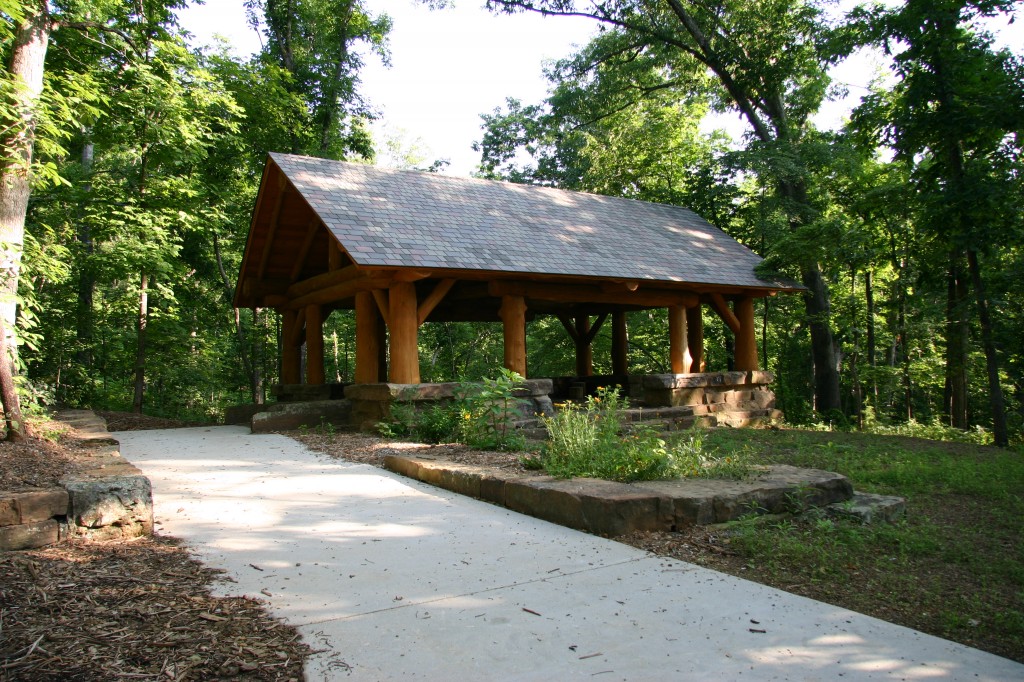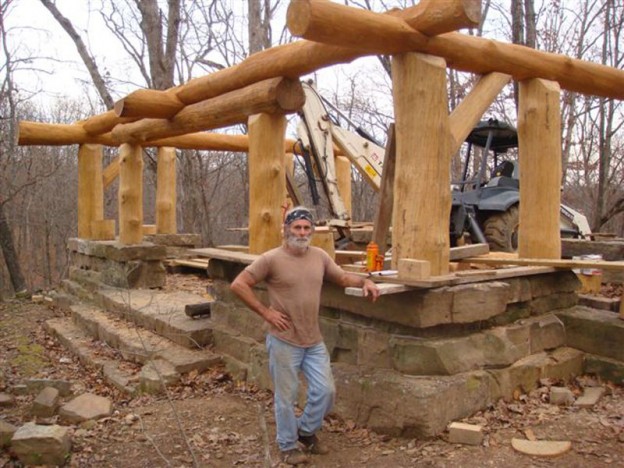
Master stone-mason Robert Runyon takes time to pose for a photo while building the pavilion
Our initial project in 2003 was to save a 67-acre tree-covered hillside located about one mile east of downtown Fayetteville when the property was offered for sale. The land’s owner had allowed trails to be built, and for over a half century the area was very popular for walks in the woods. FNHA marshaled public support and committed to contributing $300,000 toward the total purchase price of $1,300,000. The City purchased the property, now called Mt. Sequoyah Woods, in January 2003 and a contiguous 30-acre tract was donated to the City in April 2006. Part of our commitment was the construction of a CCC-style stone and timber pavilion near the southeast corner of the natural-area park. We made the final payment to the City in 2008, and FNHA now holds a conservation easement protecting Mt. Sequoyah Woods.
In early 2005 a University of Arkansas student intern was asked to research conservation strategies. His work suggested developing a conservation priority ranking to focus our efforts on the “best” natural area candidates for conservation before the rapid development occurring in the area consumed them. The resulting project, The Urban Forest Conservation Assessment for Fayetteville, Arkansas, was supported by a grant from the Arkansas Forestry Commission’s Urban Forestry Program and by the U.S. Forest Service. It was guided by a Science Advisory Committee and used GIS methodology that was developed by a specialist at The Nature Conservancy. It used available GIS data bases from local, state, and federal sources to generate indices that would indicate the ecological health and condition of parcels of land. These data were used to develop a questionnaire that was used to obtain public input, and the combined results were then prioritized to develop a Conservation Priority Ranking for land parcels in Fayetteville and the outlying areas. Public input emphasized the importance of the potential for walking/biking trails.
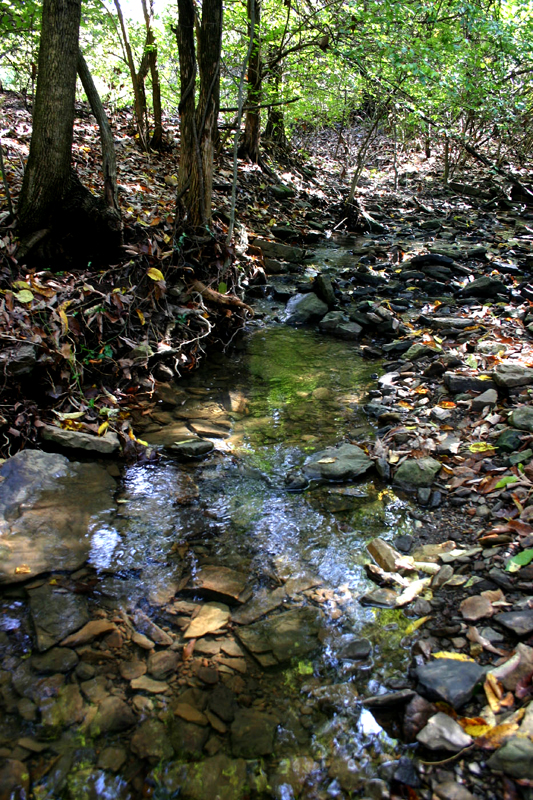
A clear running stream in Brooks-Hummel
Two immediate natural area conservation projects were identified. A highly ranked and ecologically diverse 14-acre urban forest located in the center of Fayetteville had just been put on the real estate market. In Six months we secured pledges totaling $179,500 from 160 families, individuals, and organizations, and in June 2007 the City purchased the Brooks-Hummel Nature Reserve for $495,000 total. FNHA holds a conservation easement on this park. On the west side of Fayetteville, a conservation-minded land owner was interested in donating a conservation easement to the City on a highly ranked 20-acre parcel on Kessler Mountain. The proposed easement would allow public access to a trail winding through the forest en route to a spectacular bluff and ephemeral stream. FNHA worked with the owner and the City to set up the easement, and does the annual monitoring required by the conservation easement.
Additionally the results were used in the Fayetteville City Plan 2025 for Land Use which calls for a greenbelt (natural areas/agricultural) around the city that will slow urban sprawl. The Beaver Water District, which provides water to Northwest Arkansas has used our methodology to identify top priority stream restoration opportunities. FNHA won the 2006 ENVY Award (innovation category) from the Arkansas Department of Environmental Quality and was invited to make a presentation on the project at the November 2007 National Partners in Community Forestry Conference in Baltimore, Maryland. We also received an Organization Citation Award from the Southwest Regional Council of National Recreation and Park Associations in 2006 and were honored by the Arbor Day Foundation with a 2009 Project Award.
Development of a regional Green Infrastructure Plan, the next step in defining how natural areas can benefit a community, was completed in 2010. We partnered with the Arkansas Forestry Commission and Beaver Water District and were supported by a U.S. Forest Service grant. The Urban Conservation Assessment is a primary input. Four cities, part of the county and the University of Arkansas are included in the plan’s development which is based on mixing input from both the public and technical experts. Over 300 area stakeholders provided input with about 60 participants joining committees to collect GI data. One goal is to have the cities, county and University adopt the Green Infrastructure Plan as part of their Land Use Plan. Fayetteville’s City Plan 2030 for Land Use uses the Green Infrastructure Plan to define the Enduring Green Network and provide tools to assemble the Network. The Green Infrastructure Plan was recognized by the Conservation Fund in 2011 with the Stakeholder Engagement Green Infrastructure Implementation Award. In August 2014, the Northwest Arkansas Regional Planning Commission began development of the Northwest Arkansas Regional Open Space Master Plan for the communities of Benton and Washington Counties.
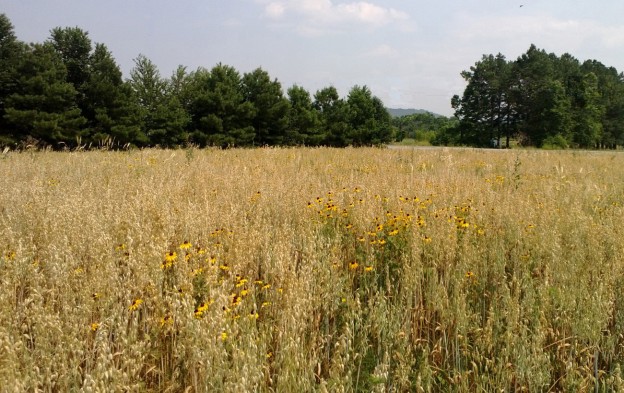
Prairie Restoration Success Underway
The Green Infrastructure Planning Environmental Working Group’s survey of the area for prairies found an upland prairie remnant in Lake Fayetteville Park. With this exciting discovery FNHA developed a plan and has since partnered with the Fayetteville Parks Department to restore a segment of about 40 acres of upland prairie. This ongoing project will help to educate folks about how much of this region looked to pioneers when the Butterfield Stagecoach travelled along the historic Butterfield Trail between St. Louis and San Fransisco. FNHA has been removing non-prairie cedars that had encroached on the area, and the City has conducted a number of prescribed burns to promote the return of native prairie flora and fauna.
FNHA has four strategic goals:
- Make exemplary natural areas accessible to all
- Improve the natural areas we have
- Influence public policy on natural areas
- Engage the community – especially young people
Citizens of Fayetteville understand the importance of having public natural spaces such as forests, prairies, and wetlands to serve as retreats from the increasingly hectic pace of city life and to retain the natural Ozark setting of our city.
We have had considerable success
We are committed to continuing our efforts
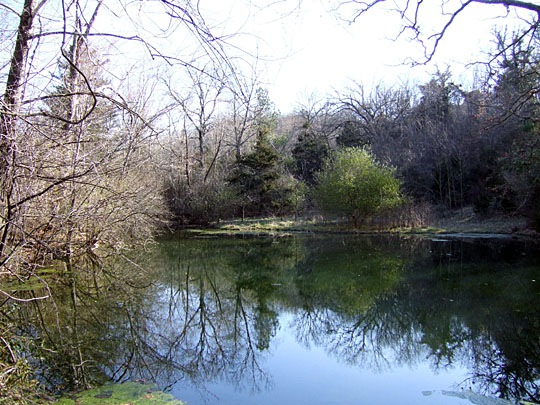
A pond at the Brooks-Hummel Nature Preserve
Perhaps FNHA’s more satisfying accomplishments are when we foster, encourage, and facilitate natural-area preservation projects within neighborhoods currently facing development.
The World Peace Wetland Prairie, a wetland area in south Fayetteville and Brooks-Hummel Nature Reserve, an upland forest tract near the center of town are examples. Additionally we helped persuade the Barber Group and Tony DePalma’s heirs to donate, in memory of Dr. DePalma, 30 wooded acres contiguous to the Mt. Sequoyah Woods bringing to 97 the total acres in that natural area.
In 2006, FNHA applied for and received a matching grant from the Arkansas Forestry Commission’s Urban Forestry Program and the U.S. Forestry Service to identify and rank the best land parcels for preservation in and around Fayetteville. To do that, the Ozark Highland’s office of the Nature Conservancy and the University of Arkansas Landscape Department teamed up to employ a computer mapping technique called “Geographic Information System” (GIS). (See “What Makes a Good Conservation Site”) The City planners and developers have embraced the results of this FNHA-sponsored research as useful information for making decisions about future development projects within the city.
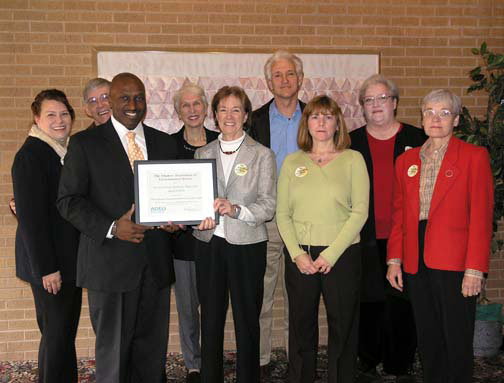
Karen Crocker, center, receives LWVWC ENVY award
The League of Women Voters of Washington County nominated FNHA’s GIS Project for the Arkansas Department of Environmental Quality Stewardship Award, known as the ENVY of Arkansas Award.Our project placed first in the Innovation category.
FNHA won a regional award when the City of Fayetteville Parks and Recreation Department nominated us for the 2007 Organization of the Year in the Southwest Region National Recreation and Parks Association, citing our on-going conservation efforts. We were awarded an Organization Citation. The Southwest Region is comprised of Arkansas, Louisiana, Oklahoma, New Mexico, and Texas.
Some Older “Accomplishments and Successes”
 FNHA Named Project Winner by National Arbor Day Foundation
FNHA Named Project Winner by National Arbor Day Foundation
At a two day celebration at Arbor Day Farm, National Arbor Day Foundation headquarters in Nebraska City, Nebraska, FNHA was among the twenty national conservation-minded organizations or individuals winning this year’s awards for work inspiring people to plant and celebrate trees. Each year the Arbor Day Award Foundation honors exemplary environmental stewards or tree planters who make a difference around the world by planting trees or through education. Representing FNHA at the Awards Banquet were Chairman Bob Caulk, Vice-Chair Karen Rollet-Crocker and Urban Forestry Coordinator Patti Erwin from the Arkansas Forestry Commission.
“The winners honored this year are doing their part to inspire the next generation of tree planters and conservationists across the United States,” said John Rosenow, chief executive and founder of the Arbor Day Foundation. “The work done with their hands and with their hearts will have a significant impact on the world today and for generations to come.”
The Foundation has given out Arbor Day awards since it was founded in 1972. Past winners include Wangari Maathai, who also won a Nobel Peace Prize; Chicago Mayor Richard Daly; Stewart Udall, former U.S. Secretary of the Interior; veteran journalist Bill Kurtis; Toyota Motor Company; and the Walt Disney Company. That’s right, we were honored and very proud be playing with the big kids!
The 2009 Arbor Day Awards given at the ceremony were: The Frederick Law Olmstead Award for extraordinary work on a regional level – Robert Thibodeaux, Church Point, Louisiana The Lawrence Enersen Award for work done on a community level –Michael Hardy, Philadelphia, Pennsylvania Media Award for outlets that capture the attention and imagination of people – Louisiana Public Broadcasting; and International Society of Arboriculture (2 awards for separate entries) Rachel Carson Award for providing nature education opportunities for children and families – U.S. Fish and Wildlife Service; World Forum Foundation, Redmond, Washington Project Award for a wide range of conservation, tree planting and tree care efforts – Fayetteville Natural Heritage Association, Fayetteville, Arkansas; the Village of Wilmette, Illinois; Reforest the Bluegrass of Lexington Kentucky; the Hardwood Forestry Fund of Reston, Virginia; Toyota Motor Manufacturing Indiana, Inc. Education Award for providing excellent educational programs that are models for other to follow – Tacoma High School’s Outdoor Academy, Kent, Washington; Kirkwood Junior TreeKeepers of Kirkwood, Missouri Celebration Award honors schools, communities and state programs that best capture the spirit of the tree-planters holiday – the City of Minneapolis; the City of Olympia, Washington Good Steward Award for tree planting and conservation efforts on private property – Blue Valley Ranch of Kremmling, Colorado Lady Bird Johnson Award for roadside beautification effort – The Streetscape Program of Fort Myers Beach, Florida Promise to the Earth Award gives recognition for sustained commitment and leadership by a corporation that partners with the Arbor Day Foundation on special projects – Allstate Insurance Company; Citi Cards
FNHA and nine other non-profits were selected by the Home Depot Foundation to submit a final grant application for the 2008 Awards of Excellence for Community Trees. The top prize of $75,000 awarded to a city our size went to Camden, New Jersey this year. It is always an honor for a small organization such as ours to be among the top groups in the country. We’ll try again.
November 2008 Lift Off!!!! Isn’t she a beauty?
MT. Sequoyah Woods – Master stone-mason and 2014 State of Arkansas Living Treasure recipient Robert Runyon finished work on the Underwood-Lindsey Pavilion in November 2008, and we couldn’t be more proud. This facility will be the cornerstone of a yet to be determined natural education program for area students and the picnic/gathering place in Mt. Sequoyah Woods. There was a ceremony at the pavilion where FNHA was presented with the paperwork for the conservation easement. A trained group will do the annual monitoring for the easement.
COMPLETED!! Plan for Green Infrastructure – Linking Arkansas Communities 2008-2009 The Arkansas Forestry Commission Urban Forestry Program, the Beaver Water District, and the Fayetteville Natural Heritage Association (FNHA) have received a $25,000 grant to develop a Plan for Green Infrastructure-Linking Arkansas Communities. Green Infrastructure is a strategic conservation planning approach designed to produce a planning tool that incorporates input from many diverse vantage points and uses Geographic information Systems (GIS) mapping. Participation of elected officials, planners, businessmen, economic development groups, landowners, environmentalists, natural resource scientists, and many other types of stakeholders is being sought. These community members will collaborate to identify the networks of natural and working lands that support the biological, cultural, and economic vitality of our region. Our project area encompasses the cities of Farmington, Johnson, Greenland, and Fayetteville with their planning areas and surrounding lands in Washington County. We have already received the support of the County Judge and the mayors or planning staffs of these cities.
Our intent is to facilitate the formulation of the Green Infrastructure Plan by providing forums, guidance, and a comprehensive data set to help community members envision the retention of an optimal green network in Northwest Arkansas. We expect that the completed map of our most precious natural and cultural resources will provide a valuable strategic tool for guiding growth, and we will seek its adoption as part of local community landuse plans. Our initial stakeholder’s meeting had:
- Explained the concepts of Green Infrastructure Planning
- Explored the compelling reasons for developing a Green Infrastructure Plan in NW Arkansas
- Had maps to view
- Outlined the next steps
- Gave an opportunity for discussion
- Had sign-up sheets for those interested in participating
Below is a summary of the initial stakeholder’s meeting presentation:
- Project Brief
- Introductory Presentation
- Green Infrastructure Planning Initial Stakeholder Meeting Presentation August 21, 2008
Nationally, green infrastructure planning projects have succeeded as a result of committed visionary leadership and significant citizen input combined with scientific conservation knowledge and practice. This project is one of four pilot studies in the Southeast Region of the USDA Forest Service and will serve as a prototype for the development of other plans in the state of Arkansas. Stay tuned!
Plan for Green Infrastructure
 FNHA Wins Major National Award for Green Infrastructure Plan Arlington, Va. — Three community-based programs will be honored during Conservation Fund‘s inaugural National Green Infrastructure Conference, Feb. 23-25, 2011 for their efforts to employ cutting-edge strategies to address local environmental and economic challenges. The National Green Infrastructure Implementation Awards will be presented on Thursday, Feb. 24, 2011 at the National Conservation Training Center in Shepherdstown, W.Va. to:
FNHA Wins Major National Award for Green Infrastructure Plan Arlington, Va. — Three community-based programs will be honored during Conservation Fund‘s inaugural National Green Infrastructure Conference, Feb. 23-25, 2011 for their efforts to employ cutting-edge strategies to address local environmental and economic challenges. The National Green Infrastructure Implementation Awards will be presented on Thursday, Feb. 24, 2011 at the National Conservation Training Center in Shepherdstown, W.Va. to:
- Green Infrastructure Planning: Linking Arkansas Communities is a partnership between the Fayetteville Natural Heritage Association, the Arkansas Forestry Commission’s Urban and Community Forestry Program and Beaver Water District to evaluate priorities for natural resource conservation in Northwest Arkansas communities in order to create a Green Infrastructure Network Map. This map provides valuable data for future decisions on local land use and green infrastructure strategies.
- Oakland County, Mich.’s Green Infrastructure Initiative reflects the collective conservation threats and opportunities brought forth by 61 local communities. This countywide green infrastructure vision presents goals, objectives and basic strategies to help communities create partnerships, build local support and embrace green infrastructure as an investment in a sustainable future.
- Carroll County Agricultural Land Preservation Program’s Leveraged Installment Purchase Agreement (IPA) is a one-of-a-kind financing program designed to significantly increase the pace of conservation easement acquisition. IPAs enable Carroll County, Md., to secure conservation easements at a fraction of the cost of cash payments while simultaneously providing numerous financial benefits to landowners. Employing one of the most successful agricultural land preservation programs in the country, the county has protected more than 60,000 acres of farmland from urban sprawl since 1979.
Plan for Green Infrastructure – Linking Arkansas Communities 2008-2009 Project Description: A grant in the amount of $25,000 has been given by the USDA Forest Service to the Arkansas Forestry Commission Urban and Community Forestry Program to develop a Plan for Green Infrastructure-Linking Arkansas Communities, 2009-2010. Fayetteville Natural Heritage Association and the Beaver Water District are partners. We will collaborate with elected officials, planners, businesses, economic development groups, landowners and other stakeholders in Farmington, Johnson, Greenland, Fayetteville and surrounding areas of Washington County. The plan is one of four Green Infrastructure pilot studies supported by the Southeast Region of the National Forest Service.
The Green Infrastructure Plan will take a strategic approach to provide a rational, scientific, and predictable planning tool for coordinating both conservation of natural resources and encouragement of growth.
The final Green Infrastructure Plan will be a blueprint for our future that combines economic, social, and environmental concerns to link protection of our land and water resources with our future growth.
- Project Brief
- Introductory Presentation
- Green Infrastructure Planning Initial Stakeholder Meeting Presentation August 21, 2008
REPORT –
Green Infrastructure Planning-Linking Arkansas Communities
FNHA is really excited to announce the successful completion of the Green Infrastructure Planning – Linking Arkansas Communities grant project. The final report has been written and published and is available in PDF format right here on our website!
The maps that were produced from data gathered by the working groups are published in the report body with each map linked to a co-responding PDF file that may viewed with the zoom feature or may be downloaded and printed.
The Green Infrastructure Network Map is the primary result. It is a science based assessment and summary of the communities’ shared vision of how conservation and development can be mutually beneficial. Over 200 people participated in the project; many contributed a significant amount of time.
The area covered by the Grant included Johnson, Fayetteville and Greenland on the east to Wedington Wildlife Management Area on the west. Implementation efforts include working with local leaders to include the Green Infrastructure Plan in each community’s Land Use Plan and beginning regional discussions on tools available to build green infrastructure. Since ecosystems and gray infrastructure projects come in a wide range of sizes, we are pursuing opportunities to expand the Green Infrastructure Plan to all of Washington County and Benton County.

